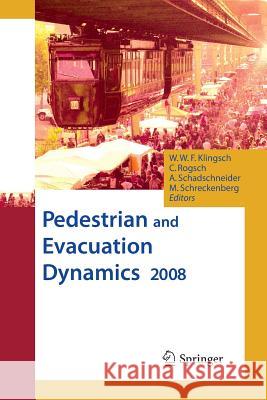Pedestrian and Evacuation Dynamics 2008 » książka



Pedestrian and Evacuation Dynamics 2008
ISBN-13: 9783662505908 / Angielski / Miękka / 2016 / 833 str.
Pedestrian and Evacuation Dynamics 2008
ISBN-13: 9783662505908 / Angielski / Miękka / 2016 / 833 str.
(netto: 768,56 VAT: 5%)
Najniższa cena z 30 dni: 771,08
ok. 22 dni roboczych
Bez gwarancji dostawy przed świętami
Darmowa dostawa!
Experiment and Evacuation.- The UK WTC9/11 Evacuation Study: An Overview of the Methodologies Employed and Some Preliminary Analysis.- Evacuation Movement in Photoluminescent Stairwells.- Automatic Extraction of Pedestrian Trajectories from Video Recordings.- Stairwell Evacuation from Buildings: What We Know We Don’t Know.- Evacuation of a High Floor Metro Train in a Tunnel Situation: Experimental Findings.- Using Laser Scanner Data to Calibrate Certain Aspects of Microscopic Pedestrian Motion Models.- Pedestrian Vision and Collision Avoidance Behavior: Investigation of the Information Process Space of Pedestrians Using an Eye Tracker.- FDS+Evac: An Agent Based Fire Evacuation Model.- Comparisons of Evacuation Efficiency and Pre-travel Activity Times in Response to a Sounder and Two Different Voice Alarm Messages.- Design of Voice Alarms—the Benefit of Mentioning Fire and the Use of a Synthetic Voice.- Enhanced Empirical Data for the Fundamental Diagram and the Flow Through Bottlenecks.- Parameters of Pedestrian Flow for Modeling Purposes.- Emergency Preparedness in the Case of a Tsunami—Evacuation Analysis and Traffic Optimization for the Indonesian City of Padang.- Case Studies on Evacuation Behaviour in a Hotel Building in BART and in Real Life.- Analysis of Empirical Trajectory Data of Pedestrians.- Model-Based Real-Time Estimation of Building Occupancy During Emergency Egress.- Experiments on Evacuation Dynamics for Different Classes of Situations.- Prediction and Mitigation of Crush Conditions in Emergency Evacuations.- Start Waves and Pedestrian Movement— An Experimental Study.- Clearance Time for Pedestrian Crossing.- Ship Evacuation—Guidelines, Simulation, Validation, and Acceptance Criteria.- Empirical Study of Pedestrians’ Characteristics at Bottlenecks.- RFID Technology Applied for Validation of an Office Simulation Model.- Study on Crowd Flow Outside a Hall via Considering Velocity Distribution of Pedestrians.- Analysis on the Propagation Speed of Pedestrian Reaction: Velocity of Starting Wave and Stopping Wave.- Simulation and Modelling.- Toward Smooth Movement of Crowds.- Modeling Evacuees’ Exit Selection with Best Response Dynamics.- Front-to-Back Communication in a Microscopic Crowd Model.- Comparison of Various Methods for the Calculation of the Distance Potential Field.- Agent-Based Simulation of Evacuation: An Office Building Case Study.- A Genetic Algorithm Module for Spatial Optimization in Pedestrian Simulation.- Opinion Formation and Propagation Induced by Pedestrian Flow.- Passenger Dynamics at Airport Terminal Environment.- Application Modes of Egress Simulation.- Investigating the Impact of Aircraft Exit Availability on Egress Time Using Computer Simulation.- Bounded Rationality Choice Model Incorporating Attribute Threshold, Mental Effort, and Risk Attitude: Illustration to Pedestrian Walking Direction Choice Decision in Shopping Streets.- A SCA-Based Model for Open Crowd Aggregation.- Hardware Implementation of a Crowd Evacuation Model Based on Cellular Automata.- Applying a Discrete Event System Approach to Problems of Collective Motion in Emergency Situations.- SIMULEM: Introducing Goal Oriented Behaviours in Crowd Simulation.- Conflicts at an Exit in Pedestrian Dynamics.- Improving Pedestrian Dynamics Modeling Using Fuzzy Logic.- Modeling the Link Volume Counts as a Function of Temporally Dependent OD-Flows.- Effect of Subconscious Behavior on Pedestrian Counterflow in a Lattice Gas Model Under Open Boundary Conditions.- Hand-Calculation Methods for Evacuation Calculation—Last Chance for an Old-Fashioned Approach or a Real Alternative to Microscopic Simulation Tools?.- Adding Higher Intelligent Functions to Pedestrian Agent Model.- “FlowTech” and “EvaTech”: Two Computer-Simulation Methods for Evacuation Calculation.- Large Scale Microscopic Evacuation Simulation.- Numerical Optimisation Techniques Applied to Evacuation Analysis.- A Multi-Method Approach to the Interpretation of Pedestrian Spatio-Temporal Behaviour.- The Microscopic Model and the Panicking Ball-Bearing.- Design of Decision Rules for Crowd Controlling Using Macroscopic Pedestrian Flow Simulation.- 3-Tier Architecture for Pedestrian Agent in Crowd Simulation.- Optimising Vessel Layout Using Human Factors Simulation.- Agent-Based Animated Simulation of Mass Egress Following an Improvised Explosive Device (IED) Attack.- A Novel Kinetic Model to Simulate Evacuation Dynamics.- Egress Route Choice Modelling—Concepts and Applications.- Architectural Cue Model in Evacuation Simulation for Underground Space.- Integrating Strategies in Numerical Modelling of Crowd Motion.- Small-Grid Analysis of Evacuation Processes with a Lattice Gas Model for Mixed Pedestrian Dynamics.- Evacuation Simulation and Human Behaviour Models in Tall Buildings.- Proof of Evacuation Routes and Safety Exits: Time Data as the Main Criteria for the Evaluation of Escape Routes and Safety Exits?.- Dependence of Modelled Evacuation Times on Key Parameters and Interactions.- A Modification of the Social Force Model by Foresight.- Models for Crowd Movement and Egress Simulation.- Modelling Pedestrian Escalator Behaviour.- Introducing a Coupled Model for Simulating Crowd Behaviour.- Evacuation Modelling of Fire Scenarios in Passenger Trains.- Pedestrian Dynamics with Event-Driven Simulation.- Psychology.- The Need for Behavioral Theory in Evacuation Modeling.- NO_PANIC. “Escape and Panic in Buildings”—Architectural Basic Research in the Context of Security and Safety Research.- Was It Panic? An Overview About Mass-Emergencies and Their Origins All Over the World for Recent Years.- Hierarchical Structure of the Mass and Group-Level Behaviors in Urban Rail Transfer Stations.- The Use of a Structure and Its Influence on Evacuation Behavior.- Miscellaneous.- Inhalation Injury of Lung and Heart After Inhalation of Toxic Substances.- Quantitative Comparison of International Design Standards of Escape Routes in Assembly Buildings.- Visualizing the Human Form for Simulation and Planning.- A Real-Time Pedestrian Animation System.- Modeling of Escape Routes According to Occupancy, Economy, and Level of Safety in Slovak Republic.
1997-2025 DolnySlask.com Agencja Internetowa
KrainaKsiazek.PL - Księgarnia Internetowa









